Enhancing Sustainable Development: Assessing a Solar Air Heater (SAH) Test Bench through Computational and Experimental Methods
Abstract
:1. Introduction
2. Proposed SAH System
3. Computational Model
3.1. Mathematical Equations
3.2. Boundary Conditions
3.3. Meshing Choice
4. Results and Discussion
4.1. Velocity Fields
4.2. Temperature
4.3. Radiation of the Heat Flux
4.4. Pressure
4.5. Turbulent Kinetic Energy
4.6. Specific Dissipation Rate
5. Energy Efficiency
6. Comparison with Experimental Outcomes
7. Conclusions
Author Contributions
Funding
Institutional Review Board Statement
Informed Consent Statement
Data Availability Statement
Conflicts of Interest
Nomenclatures
| Symbol | |||
| A | Area (m2) | Re | Reynolds number (dimensionless) |
| Gk | Generation of the turbulent kinetic energy (kg·m−1·s−3) | T | Temperature (K) |
| Gv | Generation of the turbulent viscosity (kg·m·s−2) | Tout | Outlet temperature (K) |
| Gω | Production of the dissipation rate (kg·m−1·s−3) | Tin | Inlet temperature (K) |
| H | Height (m) | t | Time (s) |
| Ht | Thermal enthalpy (J·kg−1) | U | Free-stream velocity (m·s−1) |
| I | Solar radiation (W·m−2) | U | Velocity components (m·s−1) |
| K | Thermal conductivity (W·m−1·K−1) | ui’ | Fluctuating velocity components (m·s−1) |
| k | Turbulent kinetic energy (m2·s−2) | V | Velocity (Magnitude) (m·s−1) |
| L | Length (m) | xi | Cartesian coordinate (m) |
| qi | Diffusive heat flux (J) | z | Cartesian coordinate (m) |
| Greek symbol | |||
| η | Energy efficiency (%) | σk | Prandtl number (Turbulent) (dimensionless) |
| δij | Kronecker delta function (dimensionless) | (τij)eff | Deviatoric stress tensor (Pa) |
| μ | Dynamic viscosity (Pa·s) | Φ | Equivalence ratio (dimensionless) |
| μt | Viscosity (Turbulent) (Pa·s) | Γk | Effective diffusivity of k |
| μeff | Effective turbulent viscosity (Pa·s) | Γω | Effective diffusivity of ω |
| ω | Specific dissipation rate (s–1) | Ω | Swirl number (dimensionless) |
| Abbreviation | |||
| SAH | Solar air heater | ||
| DP | Double-Pass | ||
| SP | Single-Pass | ||
References
- Elsanossi, H.I. Performance analysis of solar air heater with different absorber material in single pass. Int. Res. J. Eng. Technol. 2018, 5, 2795–2801. [Google Scholar]
- Abdullah, A.S.; Amro, M.; Younes, M.; Omara, Z.; Kabeel, A.; Essa, F. Experimental investigation of single pass solar air heater with reflectors and turbulators. Alex. Eng. J. 2020, 59, 579–587. [Google Scholar] [CrossRef]
- Salmi, M.; Afif, B.; Akgul, A.; Jarrar, R.; Shanak, H.; Menni, Y.; Ahmad, H.; Asad, J. Turbulent flows around rectangular and triangular turbulators in baffled channels a computational analysis. Therm. Sci. 2022, 26, S191–S199. [Google Scholar] [CrossRef]
- Singh, T.S.; Verma, T.N.; Jahiya, M.; Singh, P.K.; Kheiruddin, M.; Ajitkumar, K.; Singh, N.W.; Singh, H.D. Forced Convective Solar Air Heater: Effect of Thermal Storage Materials. Int. J. Appl. Eng. Res. 2018, 13, 5877–5880. [Google Scholar]
- Zhou, C.; Wang, Z.; Chen, Q.; Jiang, Y.; Pei, J. Design optimization and field demonstration of natural ventilation for high-rise residential buildings. Energy Build. 2014, 82, 457–465. [Google Scholar] [CrossRef]
- Abdulmunem, A.R.; Abed, A.; Hussien, H.; Samin, P.; Rahman, H. Improving the performance of solar air heater using high thermal storage materials. Ann. Chim.—Sci. Matér. 2019, 43, 389–394. [Google Scholar] [CrossRef]
- Ostadijafari, M.; Dubey, A. Tube-Based Model Predictive Controller for Building’s Heating Ventilation and Air Conditioning (HVAC) System. IEEE Syst. J. 2021, 15, 4735–4744. [Google Scholar] [CrossRef]
- Sharma, S.; Das, R.K.; Kulkarni, K. Computational and experimental assessment of solar air heater roughened with six different baffles. Case Stud. Therm. Eng. 2021, 27, 101350. [Google Scholar] [CrossRef]
- Moradi, H.; Mirjalily, S.A.A.; Oloomi, S.A.A.; Karimi, H. Performance evaluation of a solar air heating system integrated with a phase change materials energy storage tank for efficient thermal energy storage and management. Renew. Energy 2022, 191, 974–986. [Google Scholar] [CrossRef]
- Balakrishnan, V.; Gurunathan, M.; Parthasarathy, R.; Poluru, V.R. Experimental analysis of solar air heater using polygonal ribs in absorber plate integrated with phase change material. Therm. Sci. 2022, 26, 3187–3199. [Google Scholar] [CrossRef]
- Chan, A.L.S. Investigation on the appropriate floor level of residential building for installing balcony, from a view point of energy and environmental performance: A case study in subtropical Hong Kong. Energy 2015, 85, 620–634. [Google Scholar] [CrossRef]
- Homod, R.Z. Assessment regarding energy saving and decoupling for different AHU (air handling unit) and control strategies in the hot-humid climatic region of Iraq. Energy 2014, 74, 762–774. [Google Scholar] [CrossRef]
- Rauf, A.; Crawford, R.H. Building service life and its effect on the life cycle embodied energy of buildings. Energy 2015, 79, 140–148. [Google Scholar] [CrossRef]
- Boixo, S.; Diaz-Vicente, M.; Colmenar, A.; Castro, M.A. Potential energy savings from cool roofs in Spain and Andalusia. Energy 2012, 38, 425–438. [Google Scholar] [CrossRef]
- Oliveira Panão, M.J.N.; Camelo, S.M.; Gonçalves, H.J. Assessment of the Portuguese building thermal code: Newly revised requirements for cooling energy needs used to prevent the overheating of buildings in the summer. Energy 2011, 36, 3262–3271. [Google Scholar] [CrossRef]
- Nagaraj, M.; Reddy, M.K.; Sheshadri, A.K.H.; Karanth, K.V. Numerical Analysis of an Aerofoil Fin Integrated Double Pass Solar Air Heater for Thermal Performance Enhancement. Sustainability 2023, 15, 591. [Google Scholar] [CrossRef]
- El-Sebaii, A.A.; Aboul-Enein, S.; Ramadan, M.; Shalaby, S.; Moharram, B. Thermal performance investigation of double pass-finned plate solar air heater. Appl. Energy 2011, 88, 1727–1739. [Google Scholar] [CrossRef]
- Wazed, M.A.; Nukman, Y.; Islam, M. Design fabrication of a cost effective solar air heater for Bangladesh. Appl. Energy 2010, 87, 3030–3036. [Google Scholar] [CrossRef]
- Sopian, K.; Alghoul, M.; Alfegi, E.M.; Sulaiman, M.; Musa, E. Evaluation of thermal efficiency of double-pass solar collector with porous-nonporous media. Renew. Energy 2009, 34, 640–645. [Google Scholar] [CrossRef]
- Esen, H. Experimental energy and exergy analysis of a double-flow solar air heater having different obstacles on absorber plates. Build. Environ. 2008, 43, 1046–1054. [Google Scholar] [CrossRef]
- Ozgen, F.; Esen, M.; Esen, H. Experimental investigation of thermal performance of a double-flow solar air heater having aluminum cans. Renew. Energy 2009, 34, 2391–2398. [Google Scholar] [CrossRef]
- Teodosius, C.; Kuznik, F.; Teodosiu, R. CFD modeling of buoyancy driven cavities with internal heat source: Application to heated rooms. Energy Build. 2014, 68, 403–411. [Google Scholar] [CrossRef]
- Han, H.J.; Jeon, Y.I.; Lim, S.H.; Kim, W.W.; Chen, K. New developments in illumination, heating and cooling technologies for energy-efficient buildings. Energy 2010, 35, 2647–2653. [Google Scholar] [CrossRef]
- Satcunanathan, S.; Deonarine, S. A two-pass solar air heater. Sol. Energy 1973, 15, 41–49. [Google Scholar] [CrossRef]
- Hassan, H.; Abo-Elfadl, S. Experimental study on the performance of double pass and two inlet ports solar air heater (SAH) at different configurations of the absorber plate. Renew. Energy 2018, 116, 728–740. [Google Scholar] [CrossRef]
- Alam, T.; Kim, M.-H. Performance improvement of double-pass solar air heater—A state of art of review. Renew. Sustain. Energy Rev. 2017, 79, 779–793. [Google Scholar] [CrossRef]
- Goodarzi, M.; Nouri, E. A new double-pass parallel-plate heat exchanger with better wall temperature uniformity under uniform heat flux. Int. J. Therm. Sci. 2016, 102, 137–144. [Google Scholar] [CrossRef]
- Singh, S.; Dhiman, P. Thermal performance of double pass packed bed solar air heaters—A comprehensive review. Renew. Sustain. Energy Rev. 2016, 53, 1010–1031. [Google Scholar] [CrossRef]
- Benguesmia, H.; Bakri, B.; Driss, Z.; Ketata, A.; Driss, S. Effect of the turbulence model on the heat ventilation analysis in a box prototype. Diagnostyka 2020, 21, 55–66. [Google Scholar]

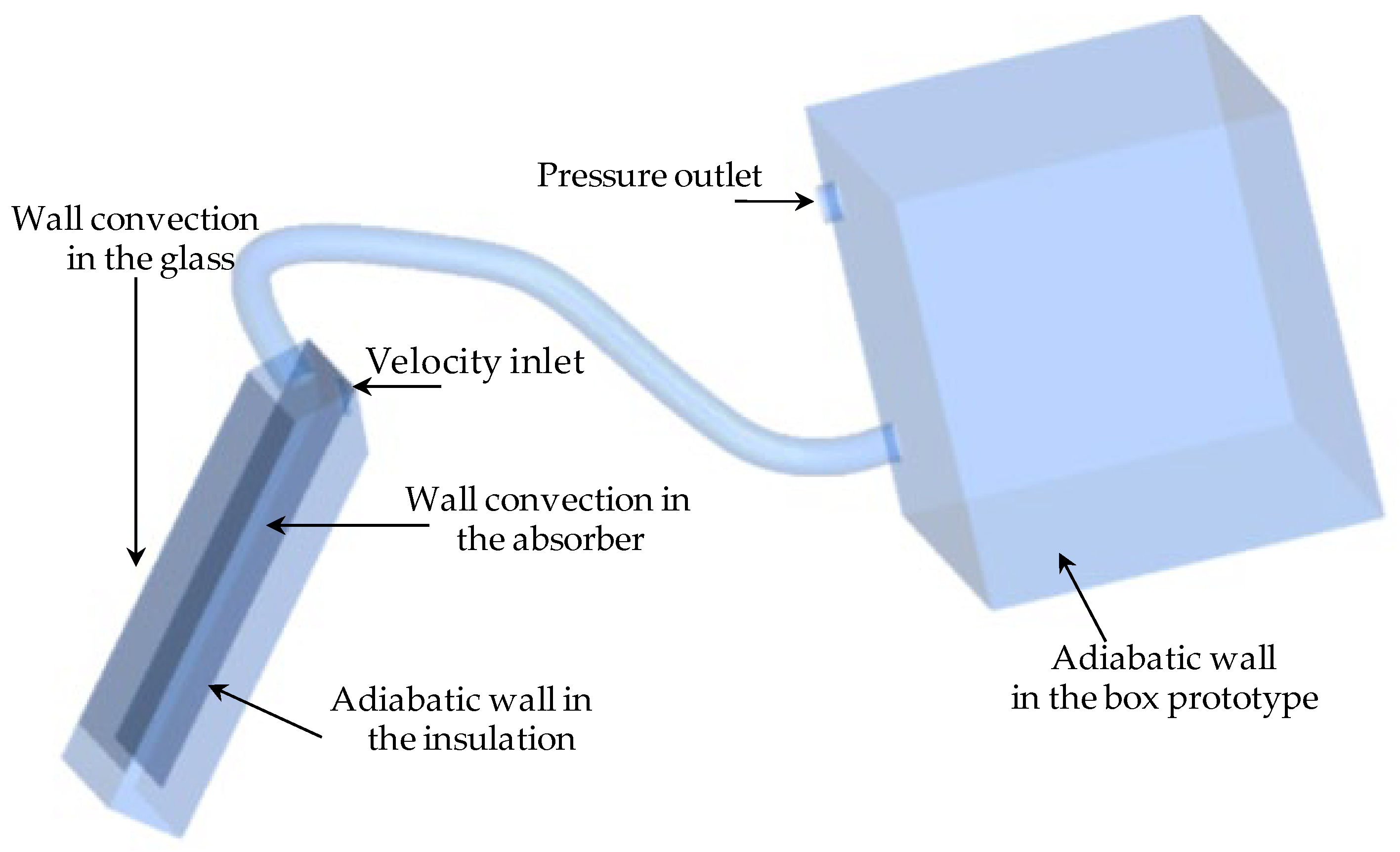


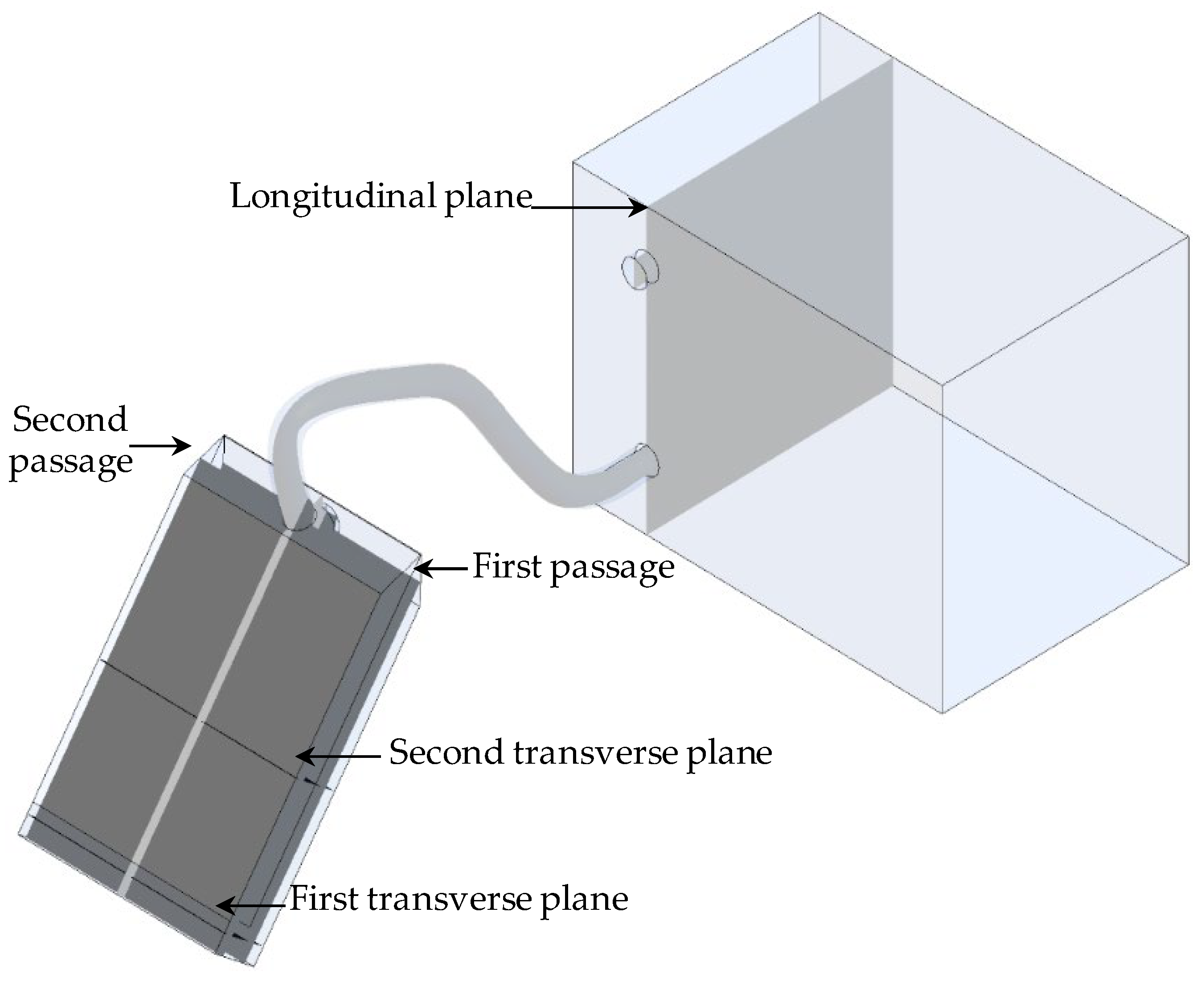
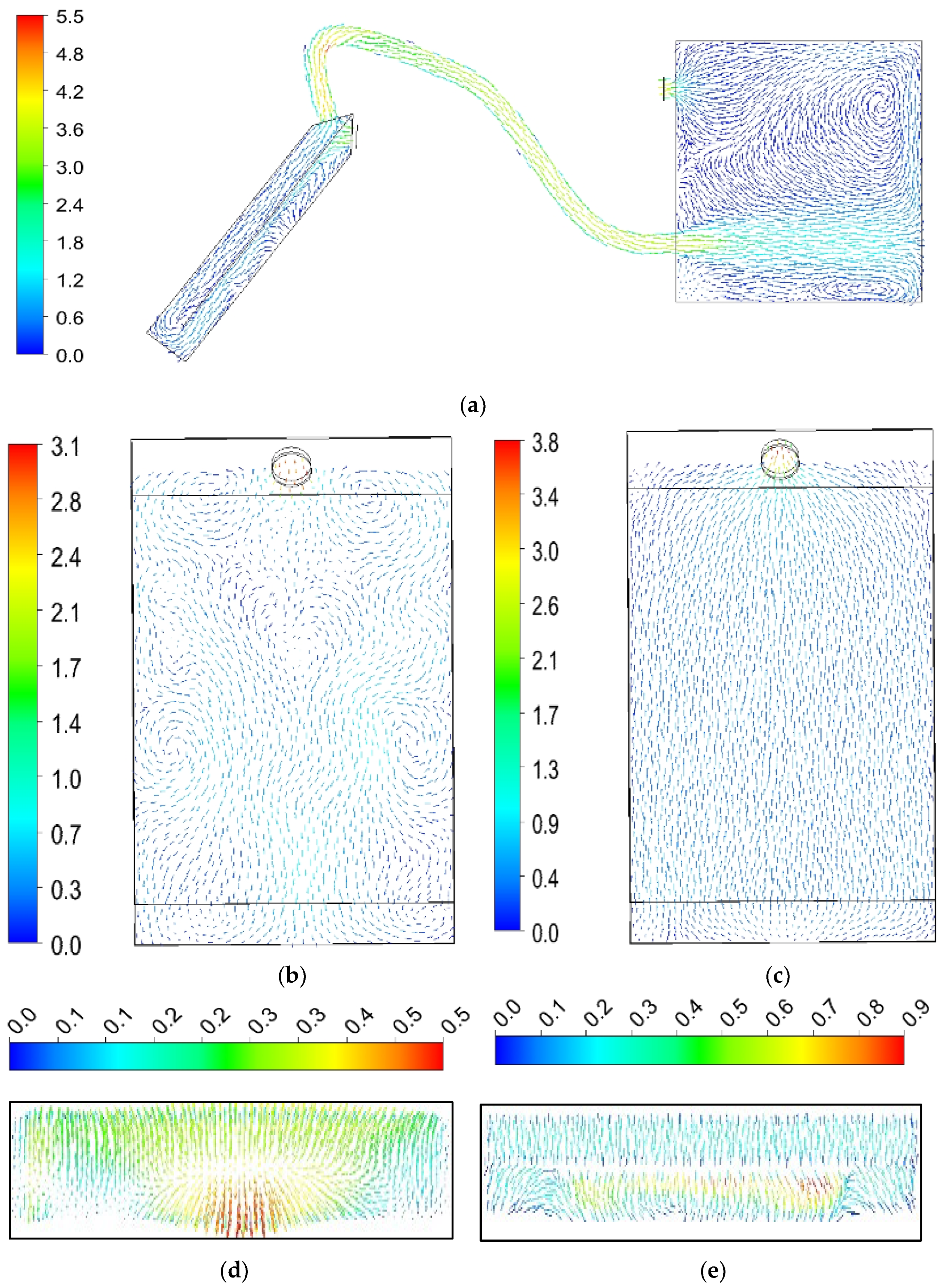
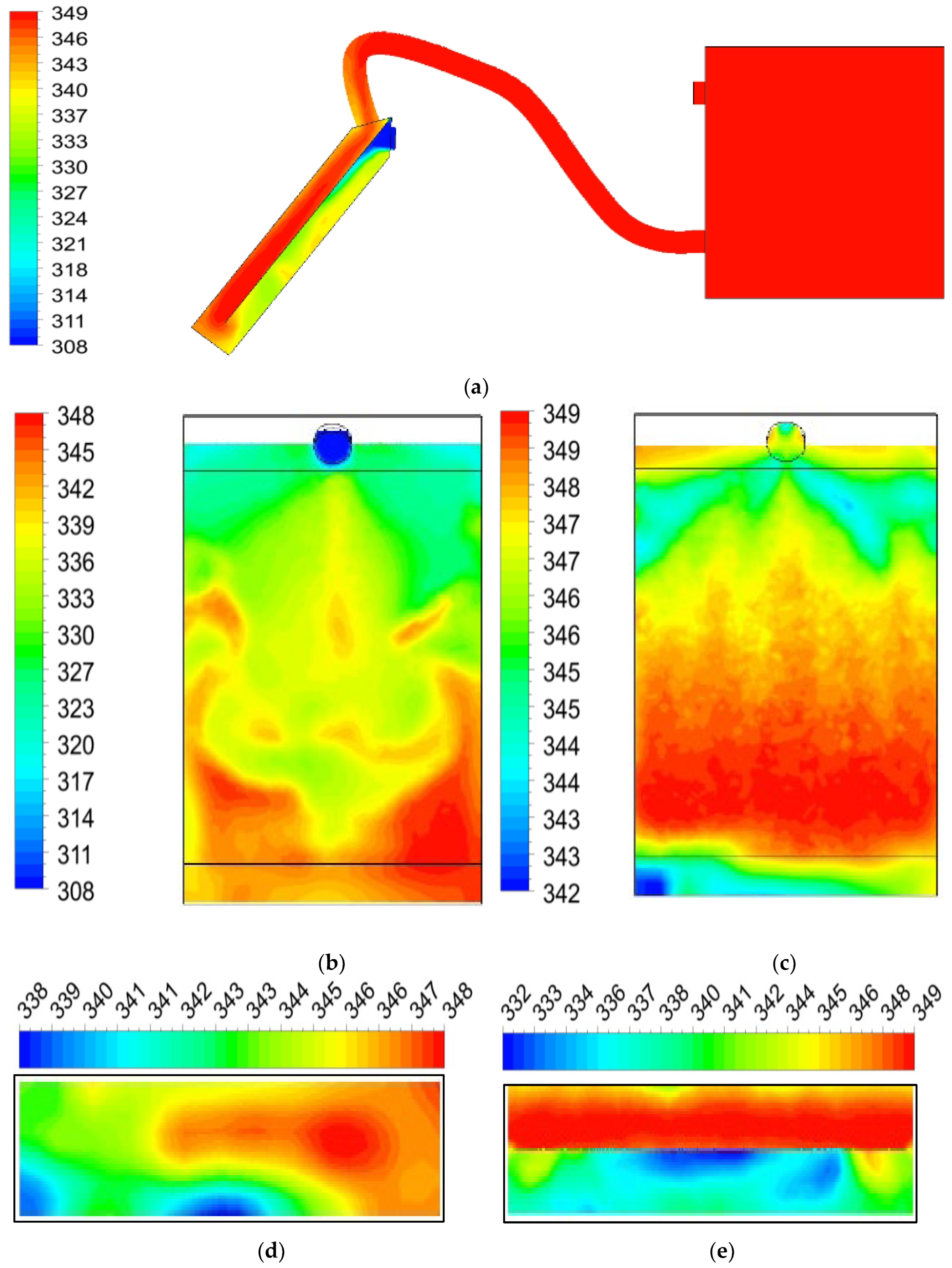
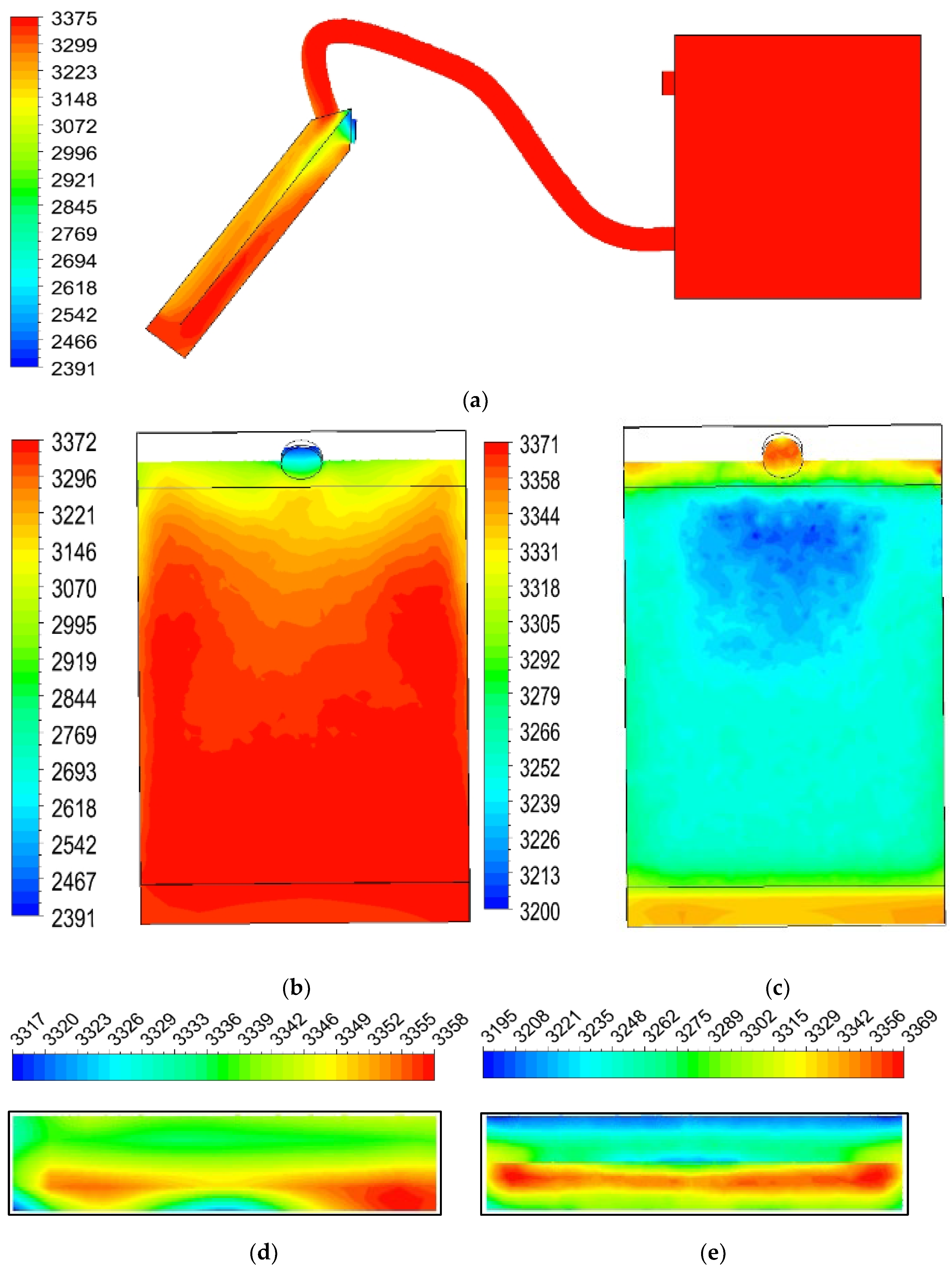
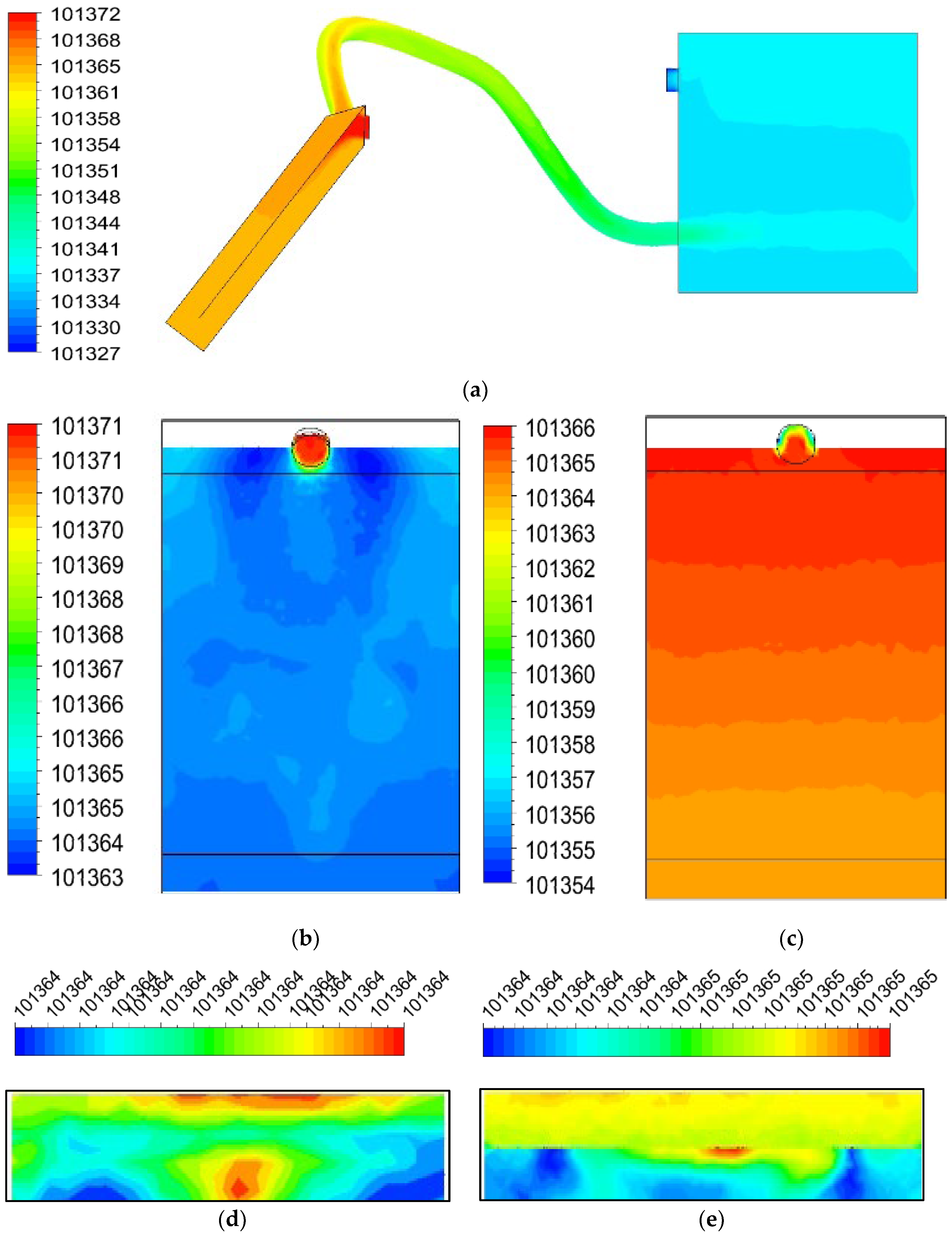

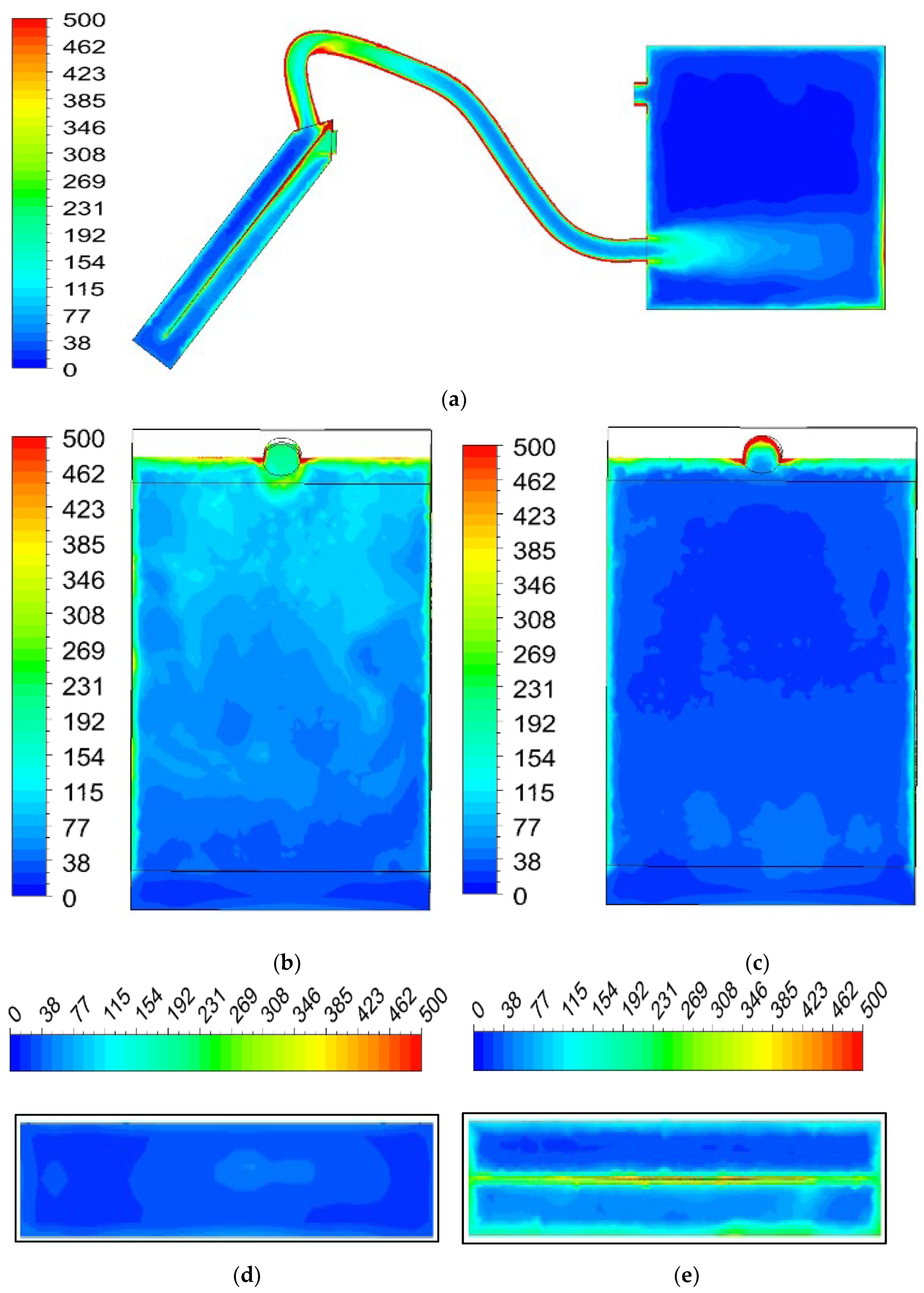
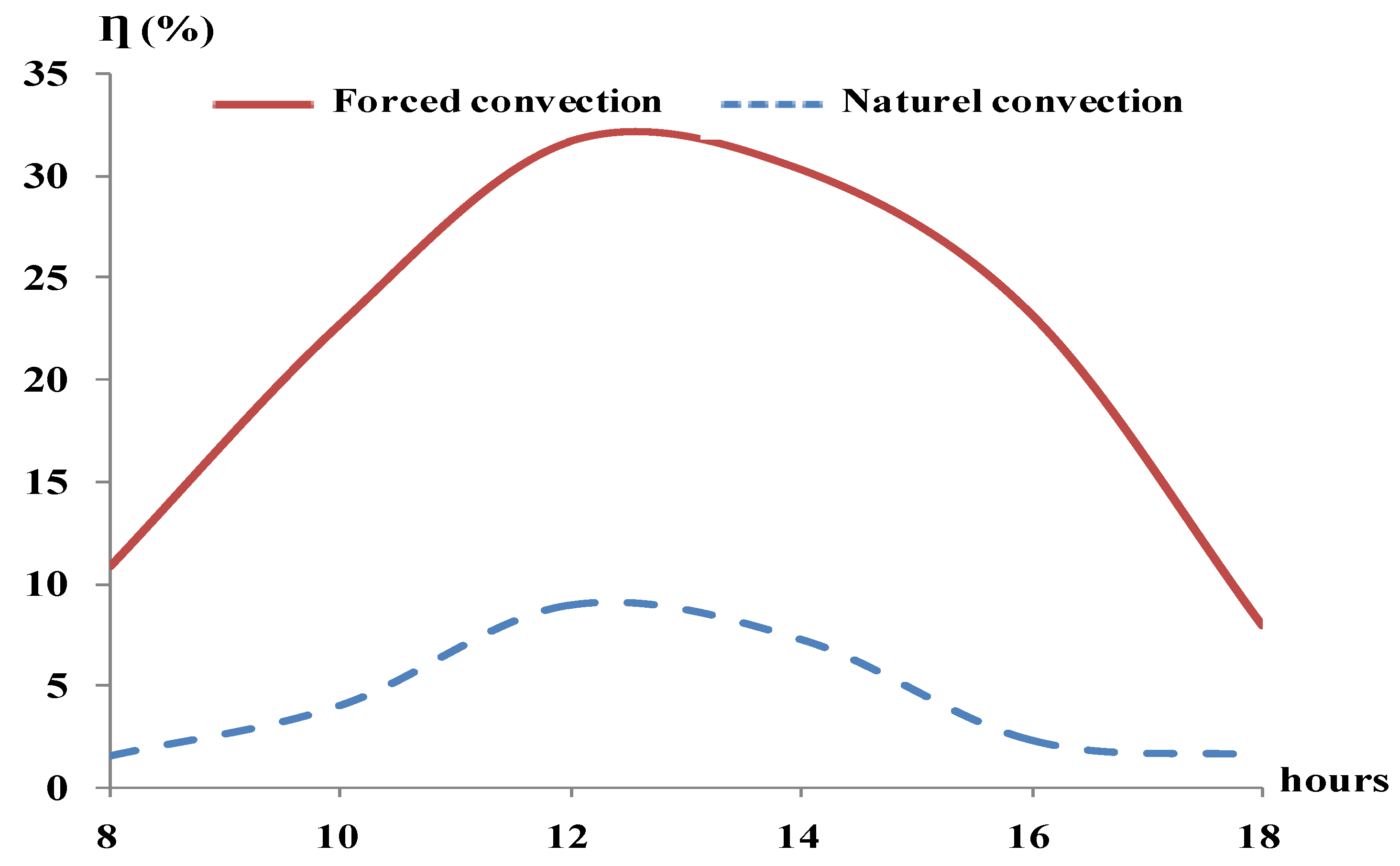
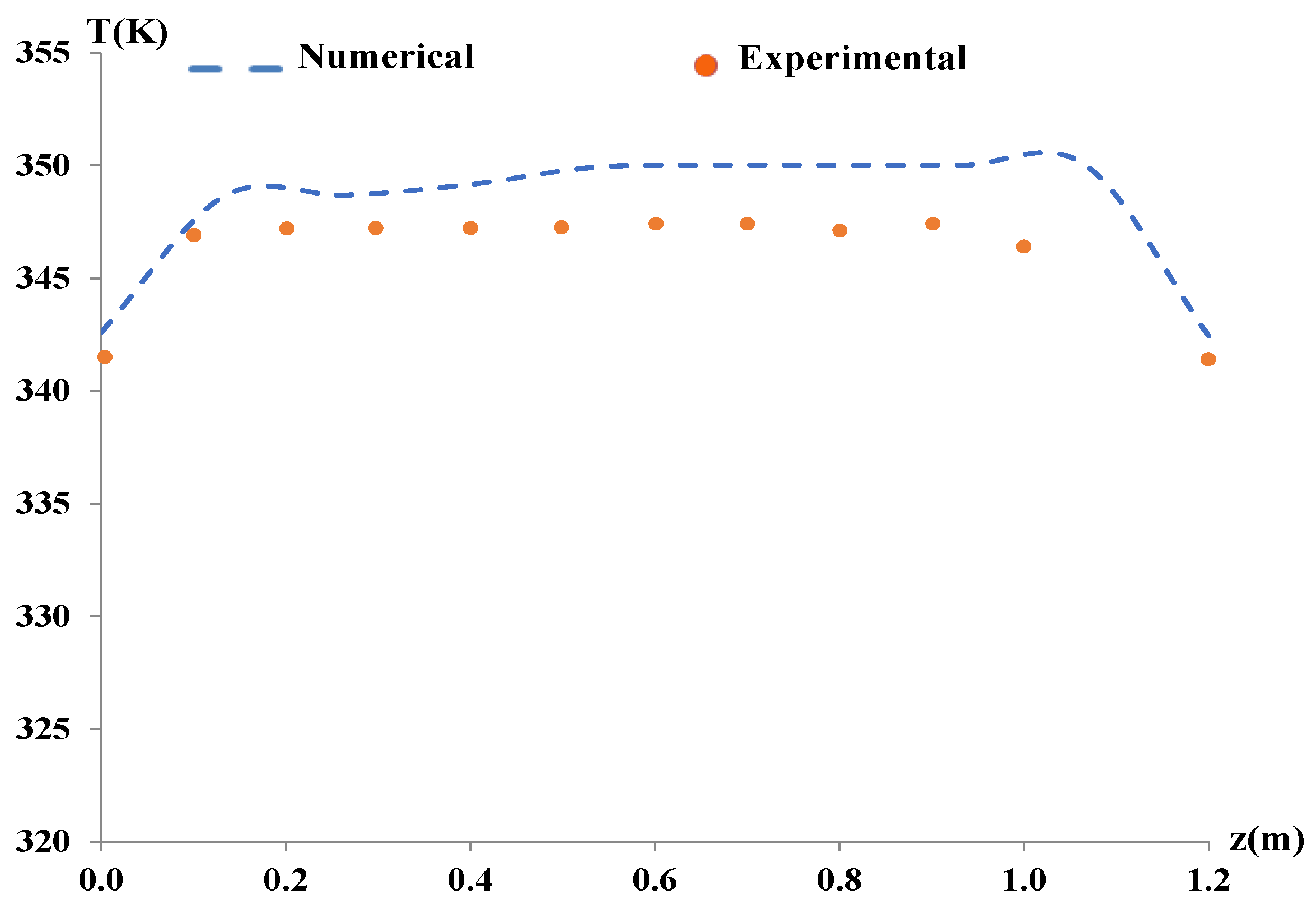
| Parameters | Value (mm) |
|---|---|
| Length | 1500 |
| Height | 1100 |
| Width | 1000 |
| Longitude | 300 |
| Length | 1086 |
| Length | 1000 |
| Width 2 | 778 |
| Height | 194 |
| Position 1 | 250 |
| Position 2 | 900 |
| Diameters | 100 |
| σω | σk | Rk | Rω | α∗∞ | α∞ | α0 |
|---|---|---|---|---|---|---|
| 2.0 | 2.0 | 6.0 | 2.95 | 1.0 | 1.9 | 1/9 |
Disclaimer/Publisher’s Note: The statements, opinions and data contained in all publications are solely those of the individual author(s) and contributor(s) and not of MDPI and/or the editor(s). MDPI and/or the editor(s) disclaim responsibility for any injury to people or property resulting from any ideas, methods, instructions or products referred to in the content. |
© 2024 by the authors. Licensee MDPI, Basel, Switzerland. This article is an open access article distributed under the terms and conditions of the Creative Commons Attribution (CC BY) license (https://creativecommons.org/licenses/by/4.0/).
Share and Cite
Bakri, B.; Benguesmia, H.; Ketata, A.; Driss, S.; Nasraoui, H.; Driss, Z. Enhancing Sustainable Development: Assessing a Solar Air Heater (SAH) Test Bench through Computational and Experimental Methods. Sustainability 2024, 16, 6055. https://doi.org/10.3390/su16146055
Bakri B, Benguesmia H, Ketata A, Driss S, Nasraoui H, Driss Z. Enhancing Sustainable Development: Assessing a Solar Air Heater (SAH) Test Bench through Computational and Experimental Methods. Sustainability. 2024; 16(14):6055. https://doi.org/10.3390/su16146055
Chicago/Turabian StyleBakri, Badis, Hani Benguesmia, Ahmed Ketata, Slah Driss, Haythem Nasraoui, and Zied Driss. 2024. "Enhancing Sustainable Development: Assessing a Solar Air Heater (SAH) Test Bench through Computational and Experimental Methods" Sustainability 16, no. 14: 6055. https://doi.org/10.3390/su16146055







